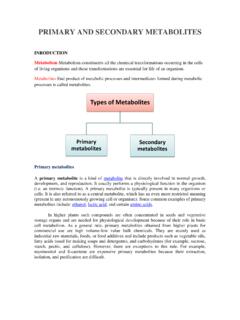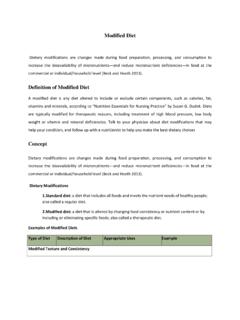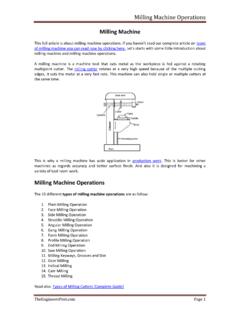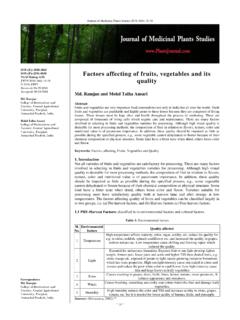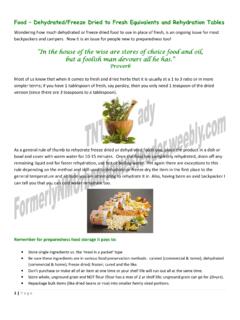Transcription of Technology of Fruits and Vegetable Processing (FST-512)
1 Technology of Fruits and Vegetable Processing (FST-512) Compiled By: Dr. Priti Jain and Dr. Pratibha Parihar (Food Sci. & Tech): First Year, Second Semester UNIT I: Indian and global scenario on production and Processing of Fruits and Vegetable ; Quality requirements of raw materials for Processing ; sourcing and receiving at Processing plants; primary Processing : grading, sorting, cleaning, washing, peeling, slicing and blanching; minimal Processing . UNIT II : Processing for pulp, puree and concentrates, especially from mango, tomato, guava, papaya, apple, pineapple, pomegranate, grapes etc.
2 Using aseptic packaging, canning, RTS fruit beverages, IQF and frozen Fruits and vegetables; for peas, mango pulps etc. UNIT III: Technology for processed products like pickles, chutneys, sauces particularly from raw mango, lime and other regional Fruits and vegetables of importance. UNIT IV: Processing of Fruits for candies, bars, toffees, jams and jellies, squashes and syrups using locally available Fruits like papaya, mango, aonla and other under-utilized Fruits . UNIT V: Dehydration of Fruits and vegetables using various drying technologies like sun drying, solar drying (natural and forced convection), osmotic, tunnel drying, fluidized fed drying, freeze drying, convectional and adiabatic drying; applications to raisins, dried figs, vegetables, intermediate moisture Fruits and vegetables.
3 Fruit powders using spray drying. UNIT I Indian and global scenario on production and Processing of Fruits and Vegetable The Green Revolution and subsequent efforts through the application of science and Technology or increasing food production in India have brought self-reliance in food. The impetus given by the Government, State Agricultural Universities, State Departments of Agriculture and other organizations through the evolution and introduction of numerous hybrid varieties of Fruits and vegetables and improved management practices have resulted in increased food production. Fruits and vegetables are among the perishable commodities.
4 They are important ingredients in the human dietaries. Due to their high nutritive value they make significant nutritional contribution to human well-being. They are the cheaper and better source, the protective foods. In developing countries agriculture is the mainstay of the economy. Fruit and Vegetable Processing are among the most important. Therefore, fruit and Vegetable Processing has been engaging the attention of planners and policy makers as it can contribute to the economic development of rural population. The utilization of resources both material and human is one of the ways of improving the economic status of family.
5 India is endowed with a remarkably heterogeneous area characterized by a great diversity of agro climatic zones. It allows for production of a variety of horticultural crops such as Fruits , vegetables, flowers, spices, plantation crops, root and tuber crops, and medicinal and aromatic crops. Fig. 1: Production share of horticultural crops in India India's diverse climate ensures availability of all varieties of fresh Fruits & vegetables. It ranks second in Fruits and vegetables production in the world, after China. As per National Horticulture Database published by National Horticulture Board, during 2015-16, India produced million metric tonnes of Fruits and million metric tonnes of vegetables.
6 The area under cultivation of Fruits stood at million hectares while vegetables were cultivated at million hectares. India is the largest producer of ginger and okra amongst vegetables and ranks second in production of potatoes, onions, cauliflowers, brinjal, Cabbages, etc. Amongst Fruits , the country ranks first in production of Bananas ( ), Papayas ( ) and Mangoes (including mangosteens and guavas) ( ). The vast production base offers India tremendous opportunities for export. During 2018-19, India exported Fruits and vegetables worth Rs. crores/ 1, USD Millions which comprised of Fruits worth Rs.
7 Crores/ USD Millions and vegetables worth Rs. crores/ USD Millions. Grapes, Pomegranates, Mangoes , Bananas, Oranges account for larger portion of Fruits exported from the country while Onions, Mixed Vegetables, Potatoes, Tomatoes, and Green Chilly contribute largely to the Vegetable export basket. The major destinations for Indian Fruits and vegetables are Bangladesh, UAE, Netherland, Nepal, Malaysia, UK, Sri Lanka, Oman and Qatar. Though India's share in the global market is still nearly 1% only, there is increasing acceptance of horticulture produce from the country.
8 Fig. 2: Major vegetables producing countries : Major Fruits producing countries Objectives of fruit and Vegetable Processing : 1) To reduce wastage and losses: Fruit and Vegetable industry is the backbone of horticulture industry as it takes care of all possible waste that occurs in spite of improvement in the distribution and marketing of fresh produce. 2) To handle glut: Produce during glut season utilized for making different processed products, thus fruit Processing helps in reducing wastage and handling excess produce during glut season. 3) To stabilize farm prices and income: It stabilizes farm price by utilizing the excess produce in value addition to provide additional income to the farmers.
9 4) To utilize marketable surplus: Processing utilizes marketable surplus as well as cull and deformed produce, to ensure remunerative returns to the growers. 5) To generate employment: Processing of Fruits and vegetables being a labour intensive helps to generate both direct and indirect employment for the masses. 6) To add variety to the diet: Value addition/ Processing make the food more attractive and palatable. 7) To ensure nutritional security. 8) To earn foreign exchange through export of processed fruit and Vegetable products. Principles of food preservation 1) Prevention or delay of microbial decomposition of food By keeping out micro-organisms (asepsis) By removal of micro-organisms (filtration) By hindering the growth or activity of micro-organisms (use of low temperature, drying, creating anaerobic conditions or using chemicals).
10 By killing the micro-organisms (using heat or irradiation). 2) Prevention or delay of self decomposition of food By destruction or inactivation of food enzymes (blanching or boiling) By prevention or delay of purely chemical reactions (use of antioxidants to prevent oxidation). 3) Prevention of damage by insects, animals, mechanical causes etc (use of fumigants, cushioning, packaging etc). Processing of fruit and Vegetable a) Primary Processing : Simple primary Processing operations like sorting, trimming, grading, washing, surface drying and packaging can be used to prepare fruit and vegetables for immediate marketing.
